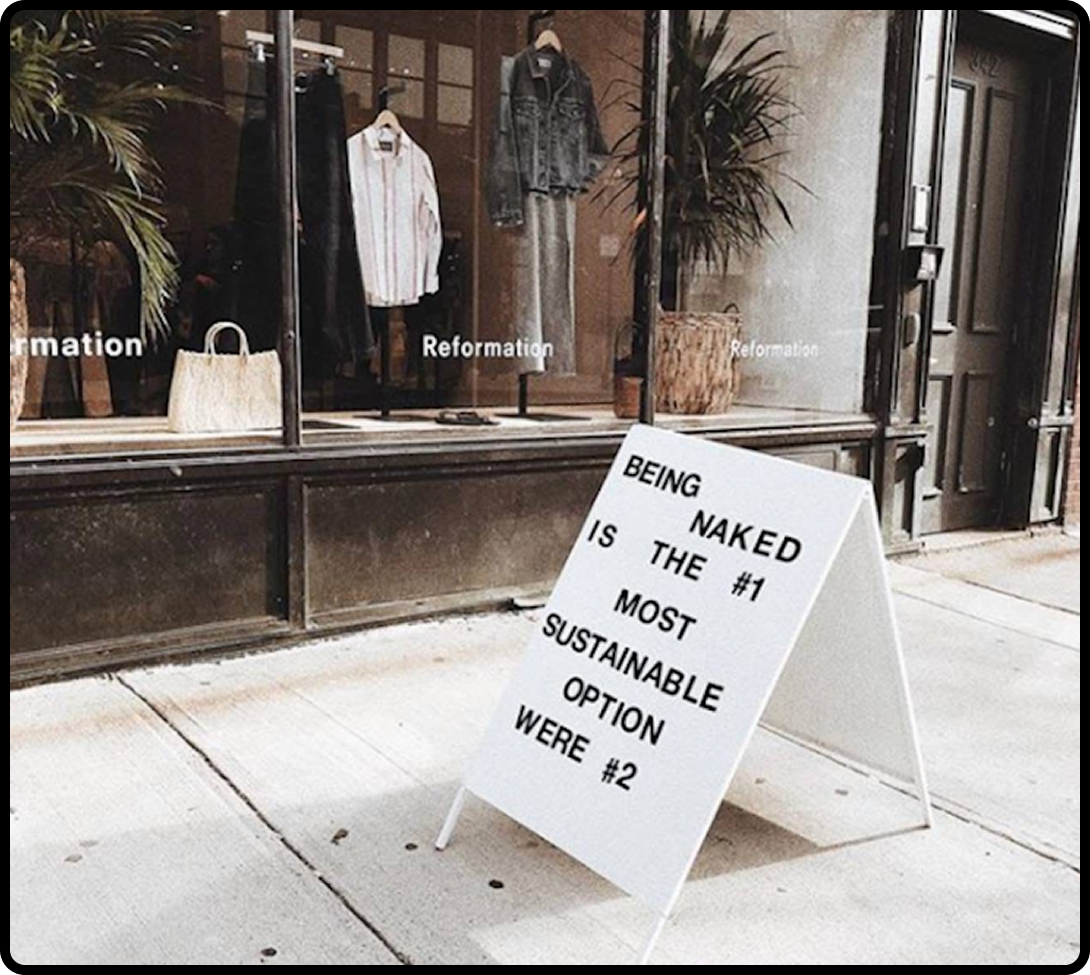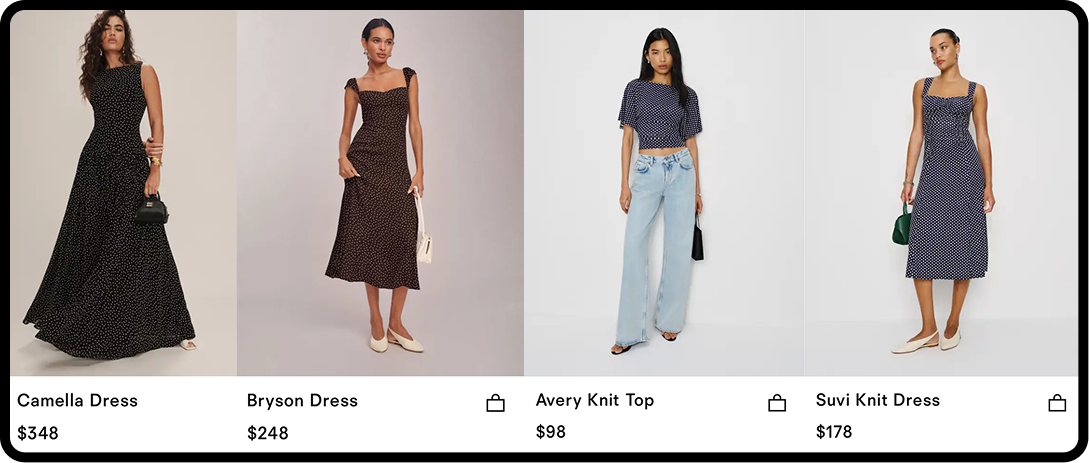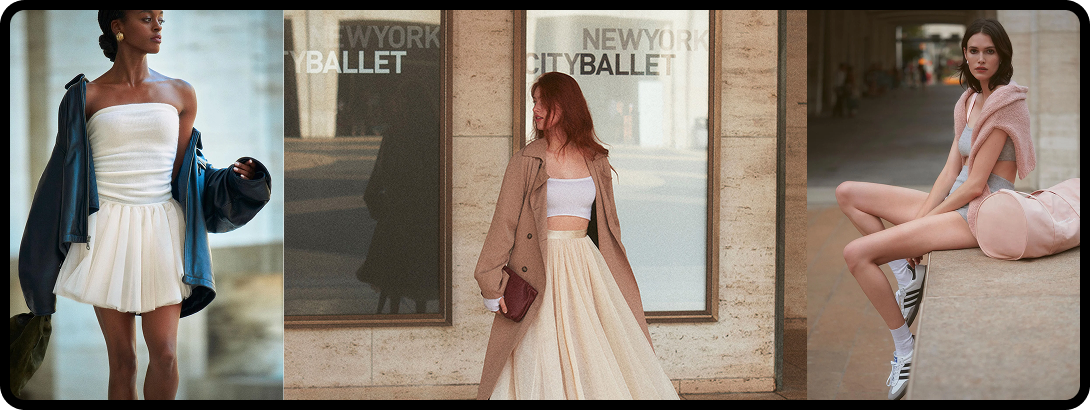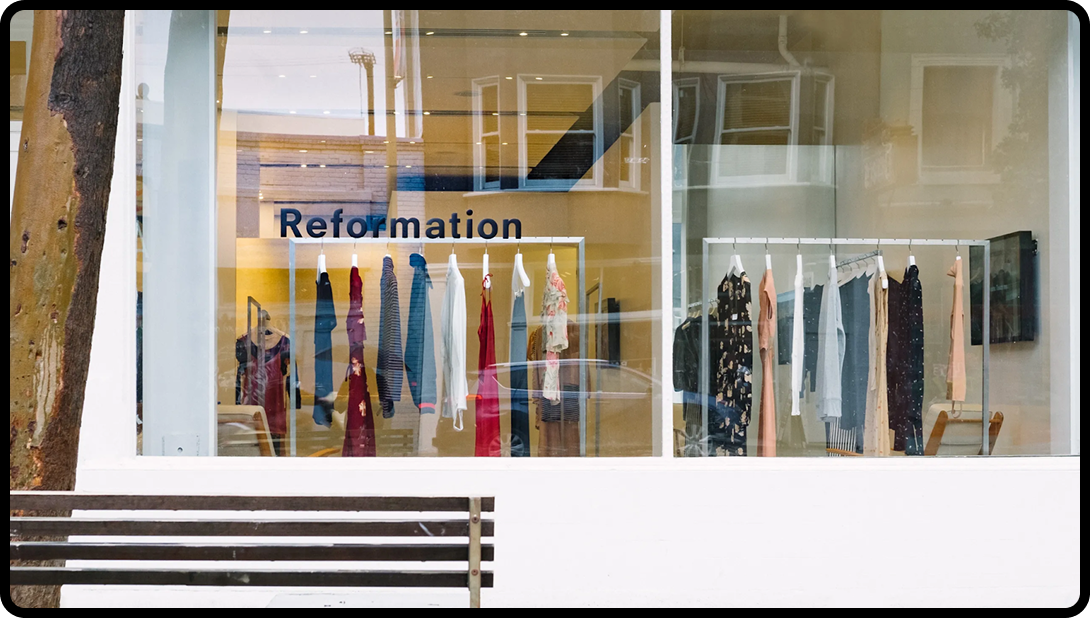Few brands have nailed the art of “conscious cool” quite like Reformation. Launched in 2009 as a vintage clothing pop-up in Los Angeles, the brand quickly became shorthand for a certain kind of effortless femininity. Ethically sourced, sustainably made, and Instagram-ready.
For over a decade, Reformation’s mix of sustainability, minimalism, and savvy celebrity alignment gave it major cultural capital. But in recent years, the same traits that built its empire, like its aesthetic, its attitude, and its audience, have come under scrutiny.
Let’s dive into Reformation marketing; its biggest brand moments, the evolution of its voice, and the turning point known on TikTok as the Scandinavian scarf scandal.
The Rise of “Ref Babe” Culture: Reformation’s Target Market

Reformation’s early marketing was all about the “cool girl who cared.” With slogans like “Being naked is the #1 most sustainable option. We’re #2,” the brand turned climate-conscious fashion into something playful and desirable.
Models looked like they just stepped off a Vespa in Rome. Product descriptions feel like descriptive texts from your bestie. And the brand’s “Ref Babes,” a term for its community of micro-influencers and shoppers, helped Reformation dominate on Instagram and Pinterest with little paid advertising spend.

Reformation’s target market is the effortlessly chic, eco-conscious woman in her 20s or 30s who wants to save the planet without sacrificing her silhouette. She’s scrolling through TikTok for outfit inspo while mentally adding things to her Reformation cart. She lives in New York, has a thing for minimalism, and she’s not just buying a dress; she’s buying into a lifestyle.
In 2023, Reformation began pivoting from pure aesthetic to deeper ethos with a series of unexpected collaborations, like its poetic, principle-driven partnership with the New York City Ballet, which used real dancers, honored the artistry of ballet, and supported the institution financially.

It was a dreamy mashup of tulle and ballet shoes. Reformation was dressing women with narratives, causes, and contradictions.
A year later, Reformation partnered with Monica Lewinsky for a voter registration initiative called “You’ve Got the Power”, putting the former White House intern-turned-anti-bullying advocate front and center. It was bold, political, and deeply Gen Z-coded. It set the internet aflame. This aligned with voting rights, drove people to register, and let Monica speak directly about power and agency.

But as Reformation widened its circle, the brand also exposed itself to controversy and broader critique, especially around the influencers it centered, and how they went about it.
Reformation’s Influencers & the Scandinavian Scarf Scandal
In April, a debate about “cultural appropriation vs. appreciation” on TikTok brought the South Asian community into a frenzy over the Reformation x Devon Lee Carlson’s Lula Top and Olivia Low Waist Skirt.
Devon Lee Carlson is an influencer whose Reformation collaboration was meant to represent her personal style: feminine, romantic, and flirty. The vibe was “looking through your bestie’s closet before a night out.” The collection focused on fabrication using sustainable materials such as organic cotton, TENCEL lyocell, and recycled fabrics, aligning with Reformation’s commitment to eco-friendly fashion.

The scarf on the Lula Top was similar to that of a dupatta, a scarf traditionally worn by South Asian women. Additionally, the Lula Top, when combined with the Olivia Low Waist Skirt, looked like a lehenga. Lehengas are traditional ankle-length skirts commonly worn on the Indian subcontinent.
As it gained popularity, however, this particular outfit became known as the “Scandinavian outfit”.
This led to a rabbit hole of South Asians on TikTok showing off their own “Scandinavian” outfits, and a whole community coming together to defend their culture that’s being rebranded.
The collaboration received a ton of heat from customers and internet users, as they pointed out that Reformation had long faced criticism for a lack of racial diversity, both in its casting and its internal culture. Former employees had been speaking up and accusing the brand of racial bias since as early as 2020.
The scarf scandal resurfaced critiques around aesthetic choices and cultural borrowing, but it didn’t stall the brand’s momentum. Reformation’s most recent collaboration was with @styledsara, aka Sara Walker, an influencer, fashion consultant, and stylist. Pieces that screamed chic, elegant, and an “easy, breezy” summer. The most staple piece was the forefront of the collaboration: the linen dress.

For better or for backlash, Reformation continues to evolve its identity through strategic collaborations with style icons like Devon Lee Carlson and Sara Walker, reinforcing its place at the intersection of fashion, sustainability, and influence.
In the end, Reformation is selling clothes, of course, but also selling a lifestyle that adapts with the times.
Reflecting on Reformation: Is It Thriving & Worth Working For?
Is Reformation a good company to work for? The answer is complicated.
On the surface, it checks a lot of boxes: buzzy brand name, a strong sustainability mission, and a presence in major style capitals like LA and NYC. But former employees have raised concerns about toxic workplace culture, particularly around issues of racial inequality. In 2020, the company faced backlash after ex-staffers alleged discriminatory practices and a lack of diversity in leadership, prompting a public apology and promises to do better.
Since then, Reformation has made moves to address internal culture, but whether it’s been enough is still up for debate. For those looking to work at the intersection of fashion and sustainability, it may still be appealing, but it’s clear that the company’s glow-up has had growing pains.
Despite the backlash, looking at it financially and culturally, Reformation is doing superb. The brand was acquired by private equity firm Permira in 2019, signaling major confidence in its growth potential. It continues to expand internationally, drop viral collaborations, and stay at the forefront of fashion’s sustainability conversation.

But the scarf scandal and the increasing scrutiny from Gen Z consumers, who want ethics and aesthetics, suggest that Reformation’s reign isn’t guaranteed. Like any brand built on “cool girl aesthetic,” it has to keep evolving to stay relevant. In a saturated market that demands transparency, inclusivity, and authenticity, staying cute simply isn’t always enough.
Still, Reformation has shown a knack for learning, even if sometimes the lesson comes after the backlash. The brand’s swift ability to pivot, whether through meaningful collaborations or adjustments to its public image, speaks to its survival instinct.
But cool branding and carbon offsets can’t paper over internal issues forever. Consumers want companies that walk the talk behind the scenes.
Is Reformation thriving? On paper, yes.
Are they worth working for? That depends on how much you value brand clout versus internal culture.
Reformation remains a powerful player in the fashion industry, but if it wants to keep its spot as a leader in both style and values, it’ll need to commit as much energy to its internal practices as it does to its outward image.
Final Ref(lection): Reformation Marketing
Reformation is a mirror of the modern fashion consumer: aspirational, aware, and occasionally contradictory. It wants to do good and look good doing it. It’s built on strong ideals but not immune to missteps. Ref is still figuring out how to balance substance with style in a world that demands both. That’s not a failure. It’s the reality of building a brand in the age of accountability.
Reformation’s story is still unfolding. It’s a brand that’s managed to stay in the conversation by evolving with culture, but now it faces a harder challenge: not just reacting to criticism, but proactively building something better. Whether that means redefining its internal culture, expanding its creative lens, or simply listening more closely to the communities it wants to serve.
The next chapter of Reformation will depend on how it empowers women, includes them, and represents them. If it can do that, Reformation might finally become revolutionary.







